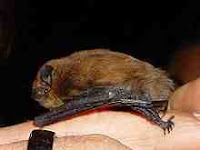I have been doing a bit of detection work involving a large group of squatters over the last week or so. Last Friday I went out with a small group of batty people from the (South Yorkshire Bat Group) to do a bat count and species identification exercise in Graves Park in Sheffield.
Four species, one tentatively identified, the count numbers were very large. Species included the Common Pipistrelle, Soprano Pipistrelle and Daubentons, plus one other that needs the bat detector sonogram recording examined to confirm the species.
A sonogram is a diagnostic image created using the ultrasonic calls of the bat. The image shows how a bat call varies with time and is used to identify those species where the differences are difficult to analyse in the field.
 |
| Little Pip |
On Tuesday evening I went to visit a family who have just discovered a colony that has take up residence in their roof space. The couple were delighted and felt very privileged to have the bats (Pipistrelles) as lodgers. Bat count 60 individuals plus 4 others passing through. Now the couple are buying a bat detector and are busy reading everything they can to find out as much information as possible about their new extended family or squatters!
We also noted that one of their neighbours also had a bat colony on their property. I will be going back one evening to check the bat numbers and species.
Wednesday evening me and the Memsahib went to visit a local pub that has had bats living in the roof space for many years. The current owners had no idea that the bats were in residence. When we alerted them, they were so chuffed that they even brought their kids outside to have have a look. Bat count 58 Pipistrelles and one we did not positively identify passing through.
In Britain all bat species and their roosts are legally protected, by both domestic and international legislation. This means you will be committing a criminal offence if you deliberately capture, injure or kill a bat. Intentionally or recklessly disturb a bat in its roost or deliberately disturb a group of bats. Damage or destroy a bat roosting place. Intentionally or recklessly obstruct access to a bat roost.
What can you do if you suspect a roost is being damaged or bats are being disturbed?
Damage, destruction and obstruction of roosts are criminal offences and a police matter. So is disturbance of bats. If you know of a location where these are happening, you should: Contact your local police station. Explain that you think a wildlife crime is being committed, and mention 'Operation Bat'.
Operation Bat is the police Standard Operating Procedure for dealing with bat-related incidents, because bats are a police wildlife crime priority. Ensure you get a reference number and then let The Bat Conservation Trust know about the incident by emailing investigations@bats.org.uk
Bats and the Law. A basic introduction to the legal protection of bats in the British Isles.
Bats and Buildings. Guidance for built environment professionals, consultants, building owners and managers on conservation actions to promote and cater for bats in buildings.
Bats Development and Planning. Basic advice for developers, planning officers and others who come across bat issues in the context of the English planning system.
Friday, we are going to yet another site to do a further bat count. I feel very privileged, I just love it.
Later....

No comments:
Post a Comment
Please put your name to your comment. Comments without a name may automatically be treated as spam and might not be included.
If you do not wish your comment to be published say so in your comment. If you have a tip or sensitive information you’d prefer to share anonymously, you may do so. I will delete the comment after reading.